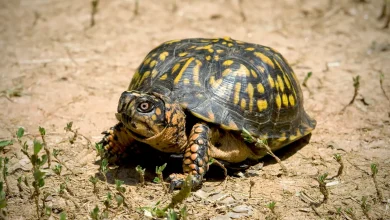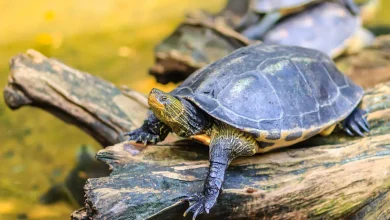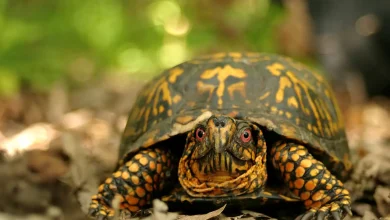The ornate box turtle is one of two recognized subspecies of the Western Box Turtle (Terrapene ornata).
These are the two subspecies:
- Ornate box turtle, Terrapene ornata ornata (Agassiz, 1857)
- Desert box turtle, Terrapene ornata luteola (Smith & Ramsey, 1952)
The desert box turtle is more adapted to life in arid conditions than the ornate box turtle.
Table of Contents
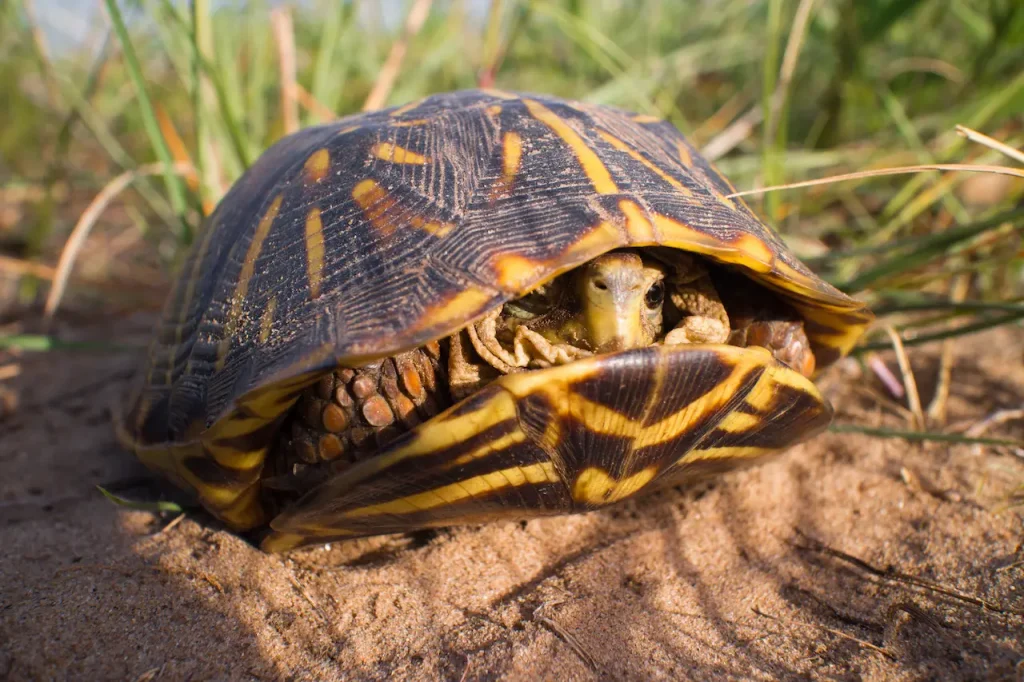
Ornate Box Turtle Distribution
The Ornate Box Turtle is native to the Great Plains of the United States and occurs from the foothills of the Rocky Mountains and eastward as far as southern Wisconsin and northwestern Indiana. The southernmost limit of its range is Louisiana and eastern Texas.
Ornate Box Turtle Habitat
The ornate box turtle is chiefly a prairie turtle found in treeless environments with scattered brush vegetation. It likes open sandy plains and grasslands, but can also venture into forests, especially along streams. They need water for drinking purposes, but unlike many other species of turtle, they do not spend much time in water. During warm summer days, ornate box turtles can seek out water or dig themselves into the soil to regulate their body temperature and avoid dehydration.
To survive the winter, the turtle will dig a shallow hole and hibernate, so the habitat must include suitable spots for burrowing. They do not share burrows. In spring, all surviving ornate box turtles in an area will wake up within one or two weeks of each other.
Body
The carapace of the ornate box turtle (and its close relative the desert box turtle) has fewer domes than that of other box turtle species and the top is flattened. The largest individuals, of both sexes, have a carapace that exceeds 15 centimetres in length.
The ornate box turtle carapace is normally black or dark brown and decorated with yellow stripes. The desert box turtle tends to have more striping than the ornate one.
Sexing Ornate Box Turtles
Males and females are quite similar to each other, but in specimens of the same age, the females are normally somewhat bigger than the males. Also, the male has a large curved inner claw on his hind feet, his cloacal opening is placed further back than in females, his tail is thicker and more powerful, and his legs show a reddish colour. In some male specimens, red can be seen on the jaw as well.
The males will typically attain sexual maturity when their plastron is 10-11 centimetres in length, while females attain sexual maturity at roughly 11-13 centimetres. It usually takes males 8-9 years to become sexually mature, while females normally need to wait until they are 10-11 years old.
What does an Ornate Box Turtle eat?
The ornate box turtle is an opportunistic omnivore. It is known to kill worms, spiders, grasshoppers, caterpillars and similar, and will happily eat carrion, including mammals, birds and amphibians. Fruit, berries, grasses and other greens are also a part of its diet.
How old can an Ornate Box Turtle get?
How old ornate box turtles get in the wild remains unknown. One of the oldest captive specimens was a 40+-year-old female.

Keeping Ornate Box Turtles as pets
Please note that catching, buying or keeping a wild caught ornate box turtle (or a captive-raised ornate box turtle without the proper documentation) may be illegal in your area.
Thinking of keeping a box turtle as a pet? The ornate box turtle is one of the most difficult species of North American turtle to successfully care for in captivity. So, unless you are willing to devote a lot of time and energy to learning about and caring for your turtle, it is better to pick one of the more sturdy species that are easier to provide with suitable conditions in captivity. When an ornate box turtle is kept in unsuitable conditions, it is prone to eye infections, ear abscesses and kidney problems.
Housing an ornate box turtle
Ornate box turtles will do best in large and properly landscaped outdoor enclosures, but this will of course require a suitable climate. If it is not possible to keep your turtle outdoors, provide it with a big indoor terrarium that includes at least one deep spot of sand or soil for burrowing. The recommended summer temperature is 80-85º F (26-29 ºC), with the opportunity for the turtle to seek out shade, moist soil and water to cool off.
Read about the natural habitat, climate conditions and behaviour of the ornate box turtle and try to replicate this in captivity. In the wild, the turtle likes to be able to move around to adjust its body temperature, e.g. shelter under bushes when the weather is hot and move out into the sun when the temperature is lower. It should be allowed to do this in captivity as well. As mentioned above, an area where the turtle can dig down is also important. The ornate box turtle will not only burrow for hibernation purposes but to regulate its body temperature during the summer too. Moist soil is a great way for the turtle to stay cool and prevent dehydration during hot days.
You can expect your turtle to be quite passive during the hottest time of the day. As the temperature decreases in the evening, it will become more active, and dawn is also a period of increased activity for this animal. If you keep your turtle indoors, try to mimic the natural cycle of dawn, day-time and dusk by adjusting the thermostat of the heater.
A commonly used substrate among keepers of ornate box turtles is peat-based potting compost mixed with sphagnum moss. Make sure the turtle has at least one area in the enclosure where the substrate is 15 centimetres deep or more (a large turtle might need more than this to burrow). Regularly check the substrate to make sure it’s moist; spray with water when necessary. Ornate box turtles that hail from sandy plains will appreciate sand in the terrarium.
Clean water should always be available to the turtle. The turtle will not only drink it but soak in it as well, so make sure the tray is large enough.
Access to real sunlight is best since full-spectrum light is necessary for vitamin D3 production in ornate box turtles. If you can not provide your turtle with real sunlight, you need to purchase special full-spectrum lights for its terrarium.
Feeding an ornate box turtle
The ornate box turtle is an opportunistic omnivore in the wild, so keeping it on an unvaried diet in captivity is not recommended. It needs both animal and plant matter in its diet. They eat quite a lot of animals and carrion in the wild and will accordingly need this in captivity as well. Examples of food that you can grow yourself or purchase from a pet shop are crickets, baby mice, mealworms and waxworms. It is common among turtle keepers to dust the food with calcium before serving it. (However, simply feeding your turtle enough calcium will not ensure good bone and shell health, since sufficient full-spectrum light is necessary for proper bone and shell formation.) In addition to meaty fare, your ornate box turtle will need greens in its diet. You can for instance give it over-ripe leafy greens, fruits and berries.
Parasites
If your turtle is wild-caught, or has come in contact with wild-caught turtles, it may be carrying parasites. Keeping it in unsuitable conditions and/or feeding it an unsuitable diet will weaken its immune system, making it easier for the parasites to cause serious health problems. Flagellates and nematodes are not uncommon problems. There is also a genus of flies that can infest the legs and make it difficult for the turtle to move around. Consult a veterinarian for more advice on how to treat possible parasite problems.
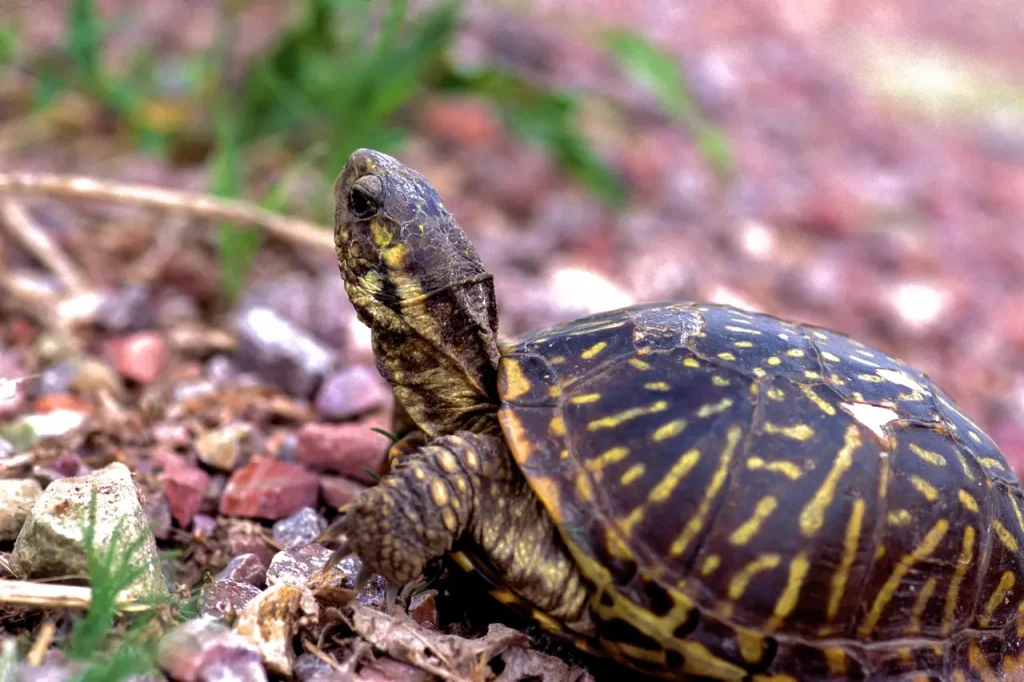
References
- Yancey, Franklin R., II. 1997. Geographic Distribution. Terrapene ornata ornata. Herpetological Review 28 (2): 95
- Vinke, T. & Vinke, S. 2004. Keeping and breeding the Ornate Box Turtle, Terrapene ornata ornata. Reptilia (GB) (32): 25-30.
- Blair, W. F. 1976. Some aspects of the biology of the Ornate Box turtle, Terrapene ornata. The Southwestern Naturalist. 21 (1): 89-103.
- Rabb, George B. 1961. Natural history of the ornate box turtle, Terrapene ornata ornata Agassiz. Copeia 1961 (1): 123-124
- Philippen, H.-D. 2004. Box turtles of the genus Terrapene. Reptilia (GB) (32): 12-18
- Converse, S. J., Iverson, J. y Savidge, J. A. 2005. Demographics of an ornate box turtle population experiencing minimal human-induced disturbances. Ecological Applications. 15 (6) : 2171-2179.
- Legler, John M. 1960. Natural history of the ornate box turtle, Terrapene ornata ornata Agassiz. University of Kansas Publications, Museum of Natural History 11 (10): 527-669
- Hill, P. M. y Wilcoxen, T. E. 2005. Terrapene ornata (Ornate box turtle). Diet. Herpetological Review. 36 (4) : 43
- Iverson, J. B. 1992. A Revised Checklist with Distribution Maps of the Turtles of the World
